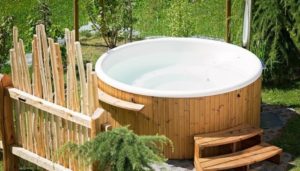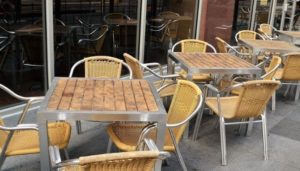In our neighborhood, there are a lot of folks that keep outdoor seating in the front yard to watch out for their own kids and neighbors’ kids as they bike and play while talking to one another whenever they can. It’s in a very vibrant neighborhood. Sometimes having privacy is what people want. I know I do.
Your own backyard is the perfect place to set up some privacy. You don’t have to spend a bunch of money on a wooden fence to create a private outdoor space for you and your family.
When planting or landscaping for privacy in your backyard, consider things you need to handle before the project, choose the plants that work best for your privacy barrier, consider how quickly you want your barrier up, and then plan and layer your natural privacy barrier.
I’d love to share some ideas with you for creating privacy by using your landscape instead of a physical boundary like a fence. So, just keep reading, and I’ll share some ideas with you.
What Should I Consider Before I Plant for Privacy?
The first thing you need to do is call 811 in the United States. They will send someone out to mark where your utility lines are. Privacy planting usually entails the digging of at least 2-foot deep holes, and you can never be too careful.
Another “outside of your control” situation that you may have to deal with before making plans on adding a natural privacy barrier to your home is the local HOA (Home Owners Association) or possibly your city, town, or community rules and regulations regarding what you can do on your property. Be sure your plans do not go against one of these authorities, or you may end up wasting your time and money. If you erect something that is against a rule or ordinance, you may have to destroy your work.
The next objective should be deciding how quickly you want your privacy. Can this be a gradual project or do you want to get some separation between you and your neighbors’ line of sight as soon as possible? That could determine the type of plants you want to invest in first.
It’s helpful to find out the best options for creating a natural screen in your area. Knowing the planting zone for your area can keep you from spending way too much money on the wrong plants. You can get this online or through your local extension services and don’t forget that local co-op employees may have an expert or two that can help.
What Should I Consider Before Choosing Plants for Privacy?
Knowing your space will help you choose the proper plants, no matter their maturity. You want to be sure not to choose a plant that’ll outgrow the space you place it in after a few years. And believe me, that’s possible. Some of your most well-known shrubs can become full-on trees if you just let them grow.
Once you choose some plants, knowing the plant’s needs is very important. For instance, part of your yard may be shaded. So you wouldn’t want to use a plant there whose tag specifies that it’s a full-sun crop.
Before you even plant your trees and bushes, you can move them around your yard while still in the pot to get an idea of what location will be best.
Another thing you should consider is maintenance. If you go for the hedges and certain trees for your privacy barriers, you’ll be spending a lot of time trimming. It may be better to go with a shorter, easier-to-maintain bed of tall grasses and plants with thick foliage that need very little maintenance. Be practical.
If you are still not sure what plants to choose, be sure to read my article on the 4 best plants for privacy.
How to Speed Up Your Privacy Plan?
You can buy a dozen gallon-sized pots full of arborvitae that will take years to grow into anything substantial, or you can buy 3 larger arborvitaes that, when placed properly, will begin providing a modicum of privacy immediately.
You can purchase bamboo that is already 10 feet high or more. It grows quickly and creates dense underbrush within months that can provide plenty of privacy. But be careful of it infiltrating someone else’s yard. It spreads just as quickly as it grows. Some people maintain large urns with bamboo inside to keep that from happening. It’s up to you.
Consider getting trees and shrubs that will provide height to your privacy barrier. Arborvitae is common, inexpensive, and can get tall, but why just use one kind of tree? Yew is another tree that can become tall. Junipers can become tall and fill out well in any space. If you don’t mind the invasive nature of bamboo, it can also be used.
Growing plants in tall planters is another method of providing privacy. Both the planters and the plants inside of them can be part of the barrier. Raising a trellis, whether made of metal, old fencing, or lattice, provides an initial barrier, but then when the vine of your choice grows up that construct, the privacy becomes even more secure.
Plan Your Planting Design and Layer It
My suggestion is to layer your plant screen with various sizes of plants and types. If you have the time to wait for your screen to grow and want to save some money, you can always buy smaller, less mature plants to plant and let them grow into the barrier you want them to be.
Different plants grow at different speeds. I’ve had a wisteria screen grow to 6 feet high and 12 feet long in one growing season. It really depends upon the plant and how well you treat it.
Speaking of wisteria, any vines you decide on will also use a trellis or a growing frame for climbing. You know what that means. The frame can be part of the privacy barrier itself.
Another long-term privacy plant is a hedge. It’s actually several shrub bushes that are coached to grow together into one large mass. If you choose correctly, you will have an evergreen hedge that can provide privacy, sound dampening, and a place for birds to enjoy. Some hedges bloom, providing food for butterflies and honeybees. The only drawback? If the hedge gets a disease, the entire thing is usually affected.
When you plant other foliage around the vines, trees, hedges, or shrubs, you can make sure that each tier is a different average height and blooms at different times of the year. You have a beautiful barrier to look at instead of just a wall of green or brown.
Layering also means you don’t place your plants all in a row very close together. Instead, you weave them forward and back along with a space between them. Don’t forget to allow for growth!
This helps deter the travel and infection of plant diseases. It also looks a little more natural. You can mix and match perennials that are not just mounded plants and vines, but also grasses and tall plants. Plant evergreens in the places that need privacy most. Then add a layer of blooming deciduous shrubs as well.
In Conclusion
I think we all have those moments when we need a break from our neighbors. Maybe you don’t want to see your neighbors hop outside in their PJs. Maybe they don’t want to see you and your friends in the pool, lying in the sun, or in the hot tub.
Even if you don’t mind waiting on the privacy, you can plant a few things that help. You can supplement larger plants with smaller plants that will grow into natural screening barriers over the next year. You can go all out and install larger, more mature plants. This can provide privacy immediately. If you’re not sure how to accomplish the right look for your privacy barriers, maybe it’s time to hire a landscape designer. Whether you do it yourself or hire someone else, creating privacy in your outdoor living space is doable with plants. It’s up to you how you do it. I just hope this article was helpful in getting you started.













